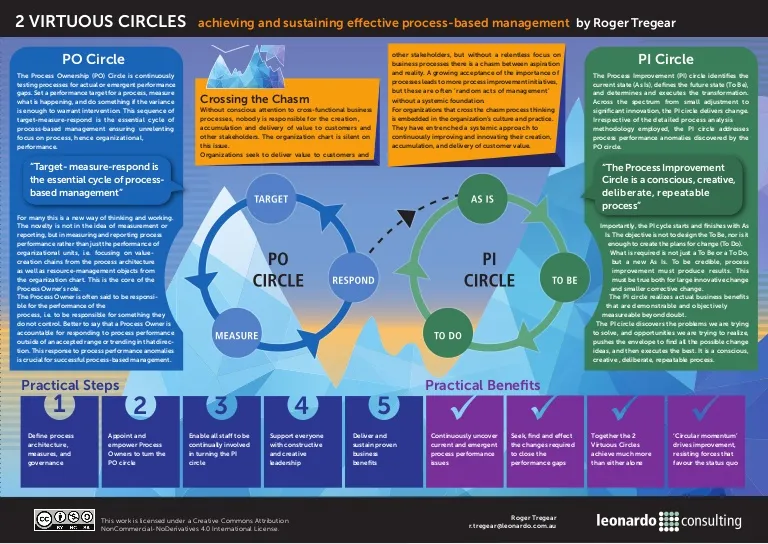The 7 Enablers of process-Based Management
Description
This is a poster version of the 7 Enablers, a way of telling the story of achieving and sustaining effective process-based management.
Transcript
2 VIRTUOUS CIRCLES achieving and sustaining eective process-based management by Roger Tregear
PO Circle
The Process Ownership (PO) Circle is continuously
testing processes for actual or emergent performance
gaps. Set a performance target for a process, measure
what is happening, and do something if the variance
is enough to warrant intervention. This sequence of
target-measure-respond is the essential cycle of
process-based management ensuring unrelenting
focus on process, hence organizational,
performance.
For many this is a new way of thinking and working.
The novelty is not in the idea of measurement or
reporting, but in measuring and reporting process
performance rather than just the performance of
organizational units, i.e. focusing on value-creation
chains from the process architecture
as well as resource-management objects from
the organization chart. This is the core of the
Process Owner’s role.
The Process Owner is often said to be
responsible for the performance of the process, i.e.
to be responsible for something they do not control.
Better to say that a Process Owner is accountable for
responding to process performance outside of an
accepted range or trending in that direction.
This response to process performance anomalies is
crucial for successful process-based management.
PI Circle
The Process Improvement (PI) circle identifies the
current state (As Is), defines the future state (To Be),
and determines and executes the transformation.
Across the spectrum from small adjustment to
significant innovation, the PI circle delivers change.
Irrespective of the detailed process analysis
methodology employed, the PI circle addresses
process performance anomalies discovered by the
PO circle.
Importantly, the PI cycle starts and finishes with As Is.
The objective is not to design the To Be, nor is it
enough to create the plans for change (To Do).
What is required is not just a To Be or a To Do,
but a new As Is. To be credible, process
improvement must produce results.
This must be true both for large innovative
change and smaller corrective change.
The PI circle realizes actual business benefits
that are demonstrable and objectively
measureable beyond doubt.
The PI circle discovers the problems we are
trying to solve, and opportunities we are trying
to realize, pushes the envelope to find all the
possible change ideas, and then executes the
best. It is a conscious, creative, deliberate,
repeatable process.
Crossing the Chasm
Without conscious attention to cross-functional business
processes, nobody is responsible for the creation,
accumulation and delivery of value to customers and
other stakeholders. The organization chart is silent on
this issue.
Organizations seek to deliver value to customers and
“The PI Circle is a conscious,
creative, deliberate,
repeatable process”
“Target- measure-respond is
the essential cycle of process-based
management”
other stakeholders, but without a relentless focus on
business processes there is a chasm between aspiration
and reality. A growing acceptance of the importance of
processes leads to more process improvement initiatives,
but these are often ‘random acts of management’
without a systemic foundation.
For organizations that cross the chasm process thinking
is embedded in the organization’s culture and practice.
They have entrenched a systemic approach to
continuously improving and innovating their creation,
accumulation, and delivery of customer value.
Practical Steps Practical Benefits
1 2 3 4 5
Appoint and
empower Process
Owners to turn the
PO circle
Define process
architecture,
measures, and
governance
Continuously uncover
current and emergent
process performance
issues
Seek, find and eect
the changes required
to close the
performance gaps
Together the 2
Virtuous Circles
achieve much more
than either alone
‘Circular momentum’
drives improvement,
resisting forces that
favour the status quo
Enable all sta to be
continually involved
in turning the PI
circle
Support everyone
with constructive
and creative
leadership
Deliver and
sustain proven
business benefits
This work is licensed under a Creative Commons Attribution
NonCommercial-NoDerivatives 4.0 International License.
Roger Tregear
r.tregear@leonardo.com.au
